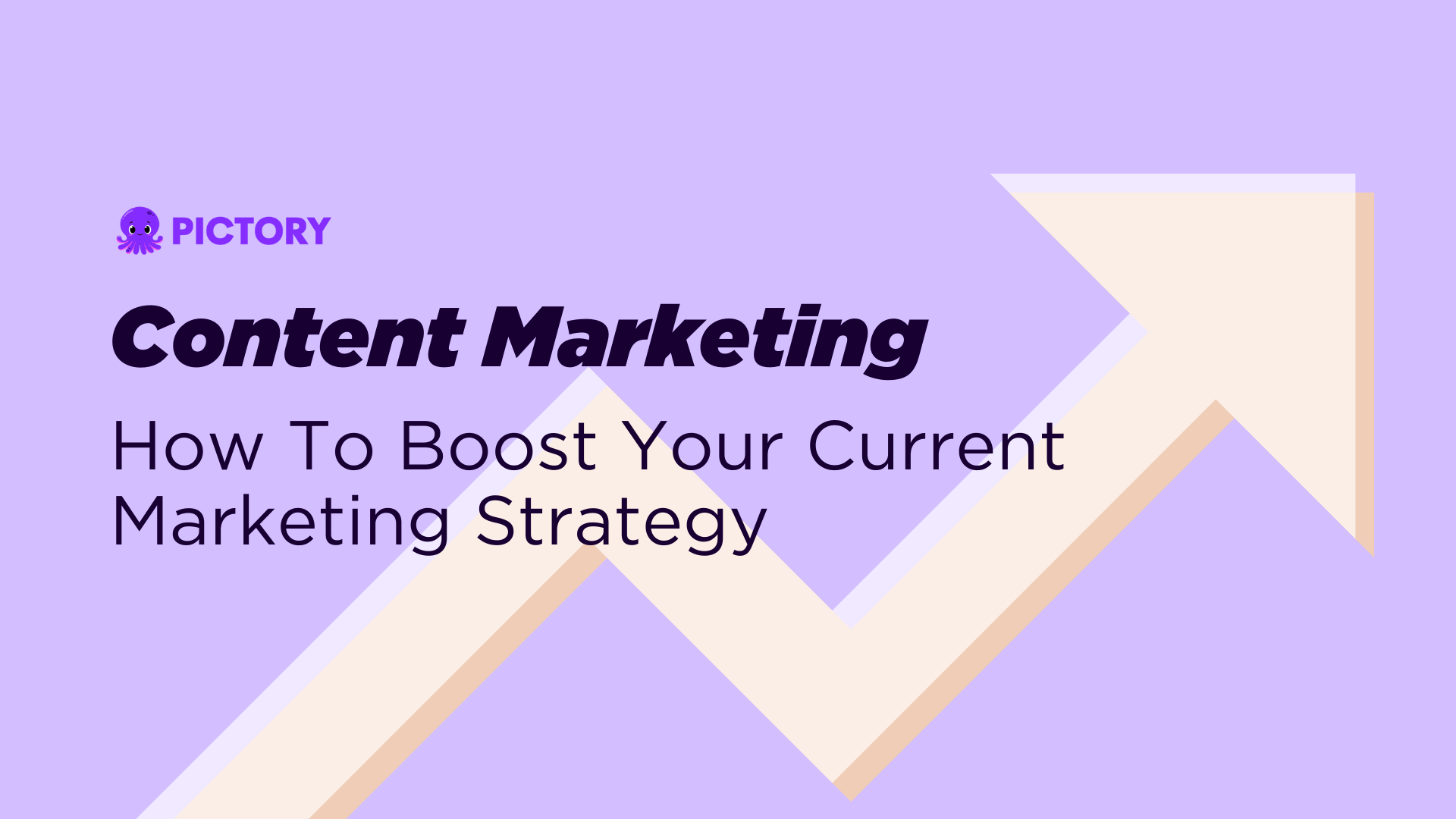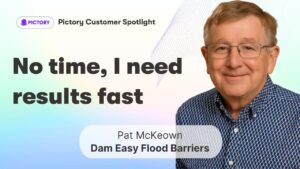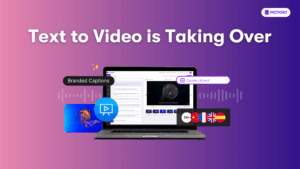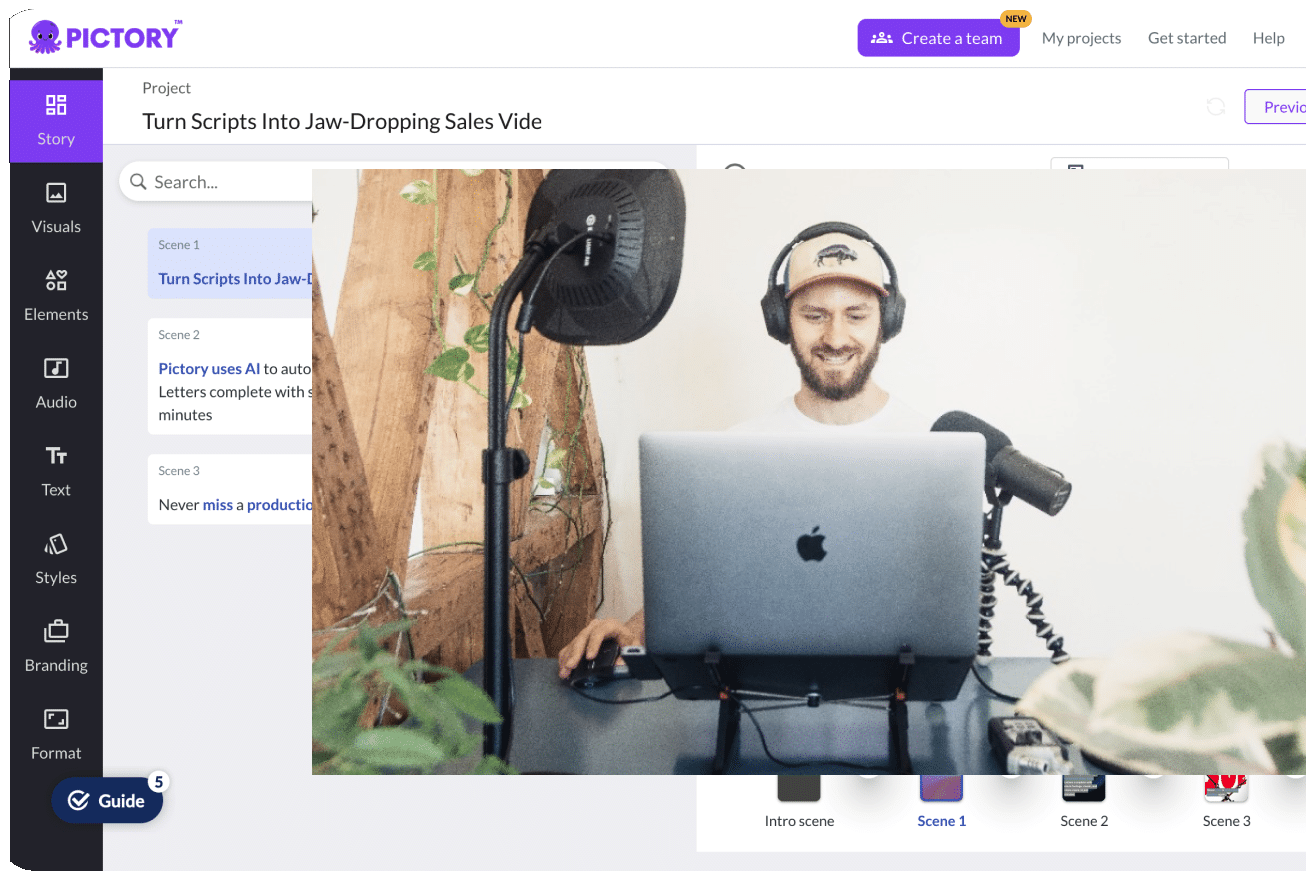Finding a competitive marketing advantage in the current online landscape isn’t easy.
However, something that seems to remain true throughout is the importance of a strong content strategy.
Whether you’re interested in establishing your company’s brand identity, generating more leads, or achieving any other business goals, we’ll show you how you can do that with great content.
TL;DR
Content marketing can take different forms, such as social media posts, videos, email newsletters, blog posts, podcasts, and user-generated content.
Content marketing aids lead generation and conversion by guiding customers through the sales funnel.
Creating a content marketing strategy involves setting clear content goals, identifying the target audience, content ideation and planning, content creation and distribution, measuring results, and adapting the strategy.
Successful content marketing builds brand authority, increases brand awareness, enhances SEO, and drives customer engagement.Common content challenges include generating consistent ideas, allocating resources, balancing quality and quantity, and staying up to date with industry trends.
AI-powered video editing tools like Pictory offer an efficient way to create engaging video content for marketing strategies, combating creative block and reducing resources needed to create great content.
Understanding Content Marketing
Many times in this article, we’ll return to how important clarity and planning are for developing a company’s marketing strategy.
On that note, here’s a quick content marketing definition to start things off:
Sometimes referred to as inbound marketing, content marketing refers to the strategic sharing of online content in the form of blog articles, social media posts, email newsletters, etc. to promote a business.
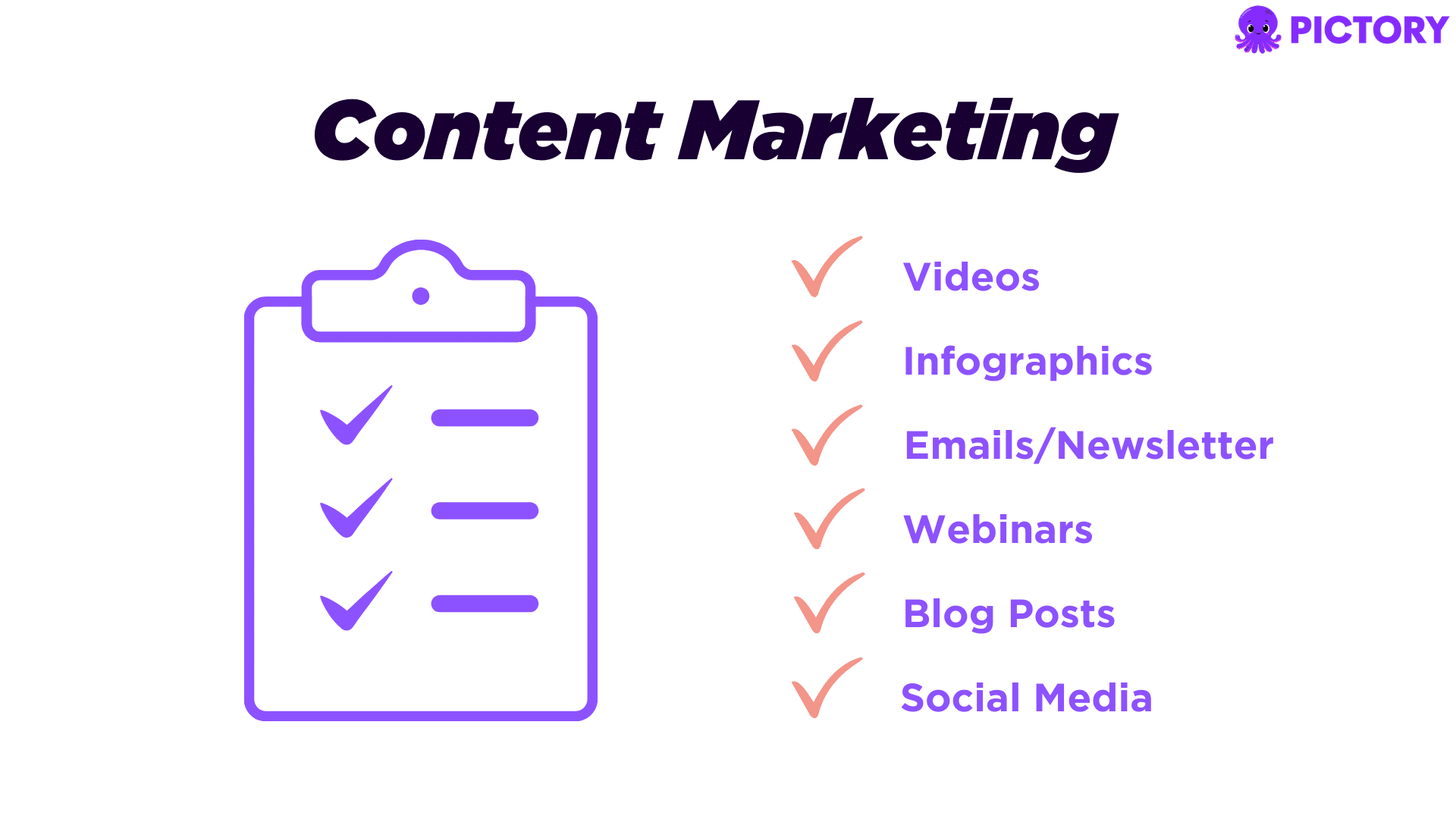
In the age of digital marketing, it’s become one of the central means of generating interest in brands and attracting customers to their sites.
How Content Marketing Compares to Traditional Marketing
Unlike traditional marketing which has relied primarily on product and brand-forward paid media marketing, content marketing is intended to do more than simply sell something to consumers.
It’s meant to provide content that can entertain, inform, assist, and provide value beyond whatever the brand is trying to promote.
For example, a paid media ad in a travel magazine announcing the new Canon vlog camera is traditional advertising.
But a video shared by the brand on YouTube filmed using the product and showing off how to use its features is considered content marketing.
How Content Marketing Complements Other Marketing Channels
The reason why content marketing works so well in the current digital marketing landscape is that most marketing platforms these days rely primarily on content to exist in the first place.
Think about it: Instagram, a major advertising machine, is nothing without Instagram posts.
The same applies to YouTube, LinkedIn, and even Google.
The online world and the marketing machines that rule it run on content.
Even traditional marketing channels work better with the addition of content marketing.
So many print and billboard ads these days include QR codes which can be scanned and used to see online content.
The way this content builds on the initial awareness created by more traditional marketing modes shows just how complementary content marketing strategies can be to other marketing channels and approaches.
Defining Content Marketing Forms and Focuses
Content marketing efforts can occur through a variety of formats and be used to target all manner of business and marketing objectives.
These are some of the options available to use in a content marketing strategy:
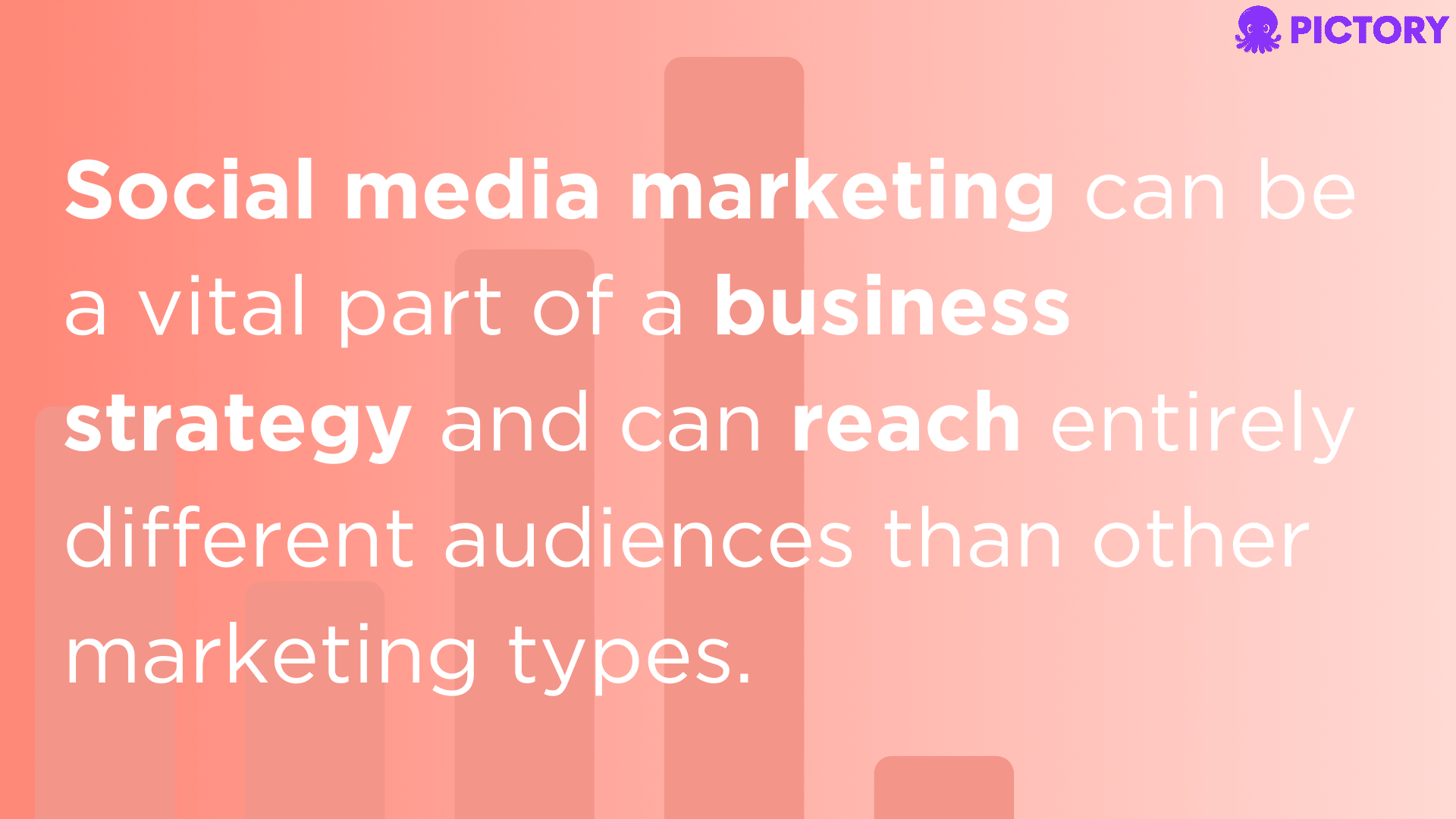
Social Media Marketing
Posting on social media accounts with platforms such as Facebook, TikTok, etc. is fundamental to every content approach.
Social media marketing can be a vital part of a business strategy and can reach entirely different audiences than other marketing types.
With this type of content, it’s important to be intentional about the platforms you use.
You also need to check if the audience and formats that each platform prioritizes are well suited to your brand and target audience.
Video Content Marketing
A recent study revealed that 92% of content marketers see a positive ROI on video marketing efforts.
Video content features heavily on social media channels but is often included on landing pages and blog posts to provide added visual interest.
Videos add an extra layer of accessibility and engagement to traditional text-based marketing strategies.
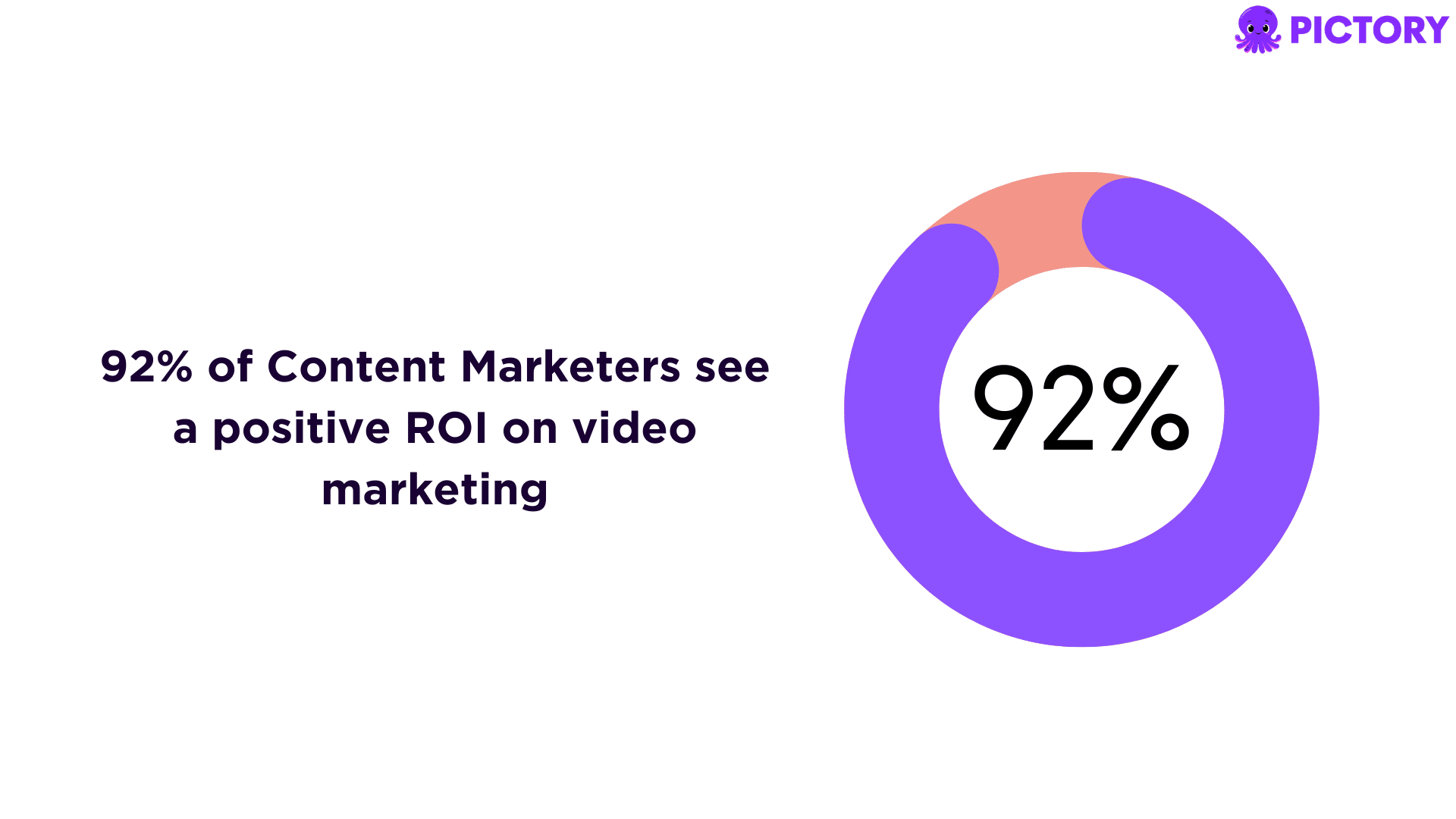
They allow for a wider range of marketing on social media channels, and let businesses highlight and repurpose blogs, articles, and other scripts.
For all the advantages of video content marketing, however, video content can be expensive and time-consuming to create when compared to other content formats.
Online video generators and AI video editors bring a more cost-effective, time-friendly solution to video marketing.
They allow you to scale video content creation without scaling resources and, in turn, make your content strategy even stronger.
Even content marketers with no video editing experience can boost their strategy with an editor like Pictory in their toolkit.
Further Reading: How AI Video Editors Empower All Levels of Content Marketers
Email Marketing
No content plan is complete without an email marketing strategy.
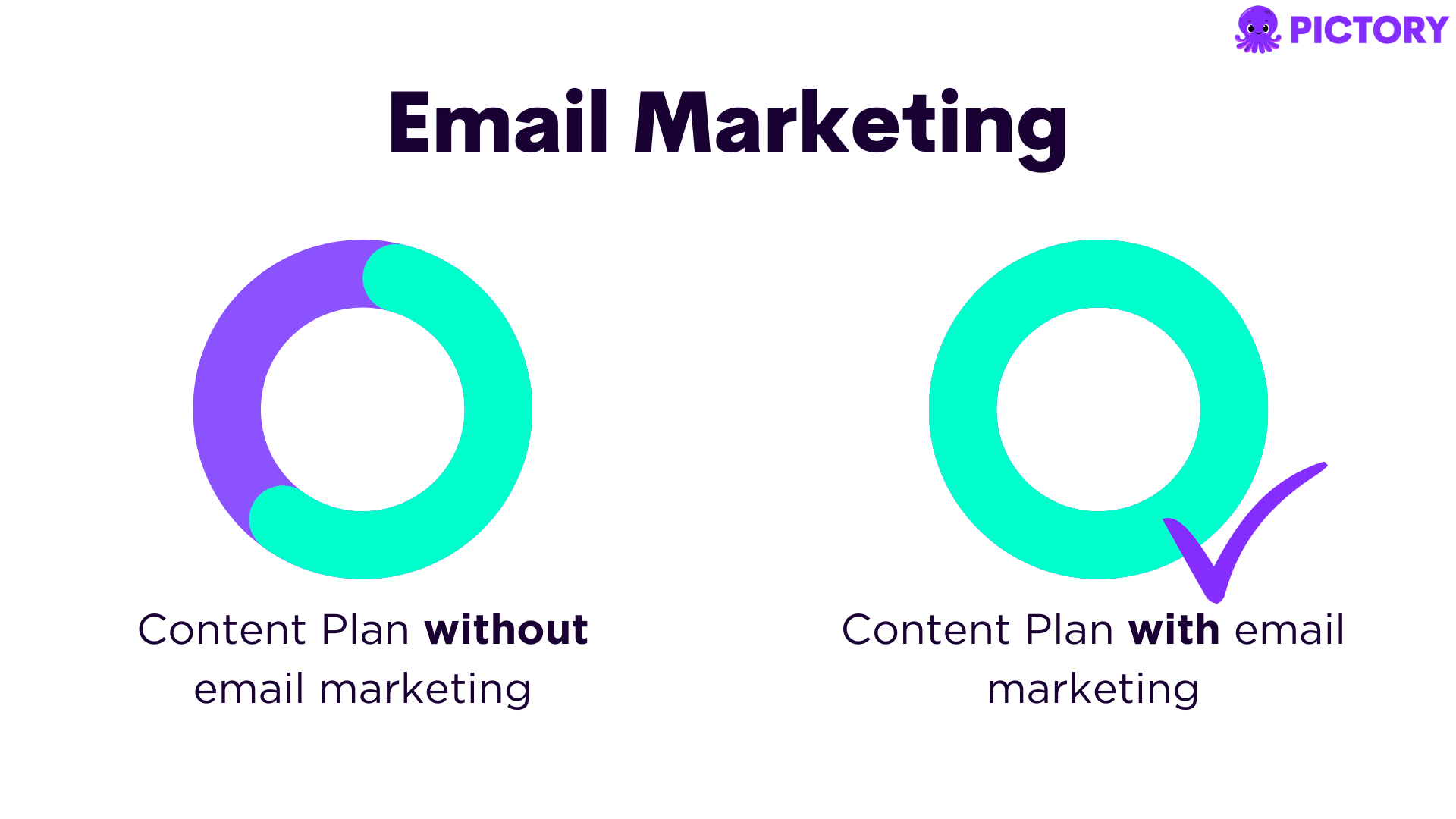
Email content usually takes the form of newsletters which online users can sign up for through a brand’s website.
The nature of email marketing makes it highly effective for creating content that is personalized and targeted directly at users who have already shown interest in a business.
Educational Content
This type of online content marketing generally takes the form of white papers, infographics, eBooks, and free courses.
The goal is usually to share relevant content with a target audience to educate them on a specific topic.
Brands can use it to help disseminate information as it relates to their product or services, or as a means of establishing thought leadership.
Blog Posts
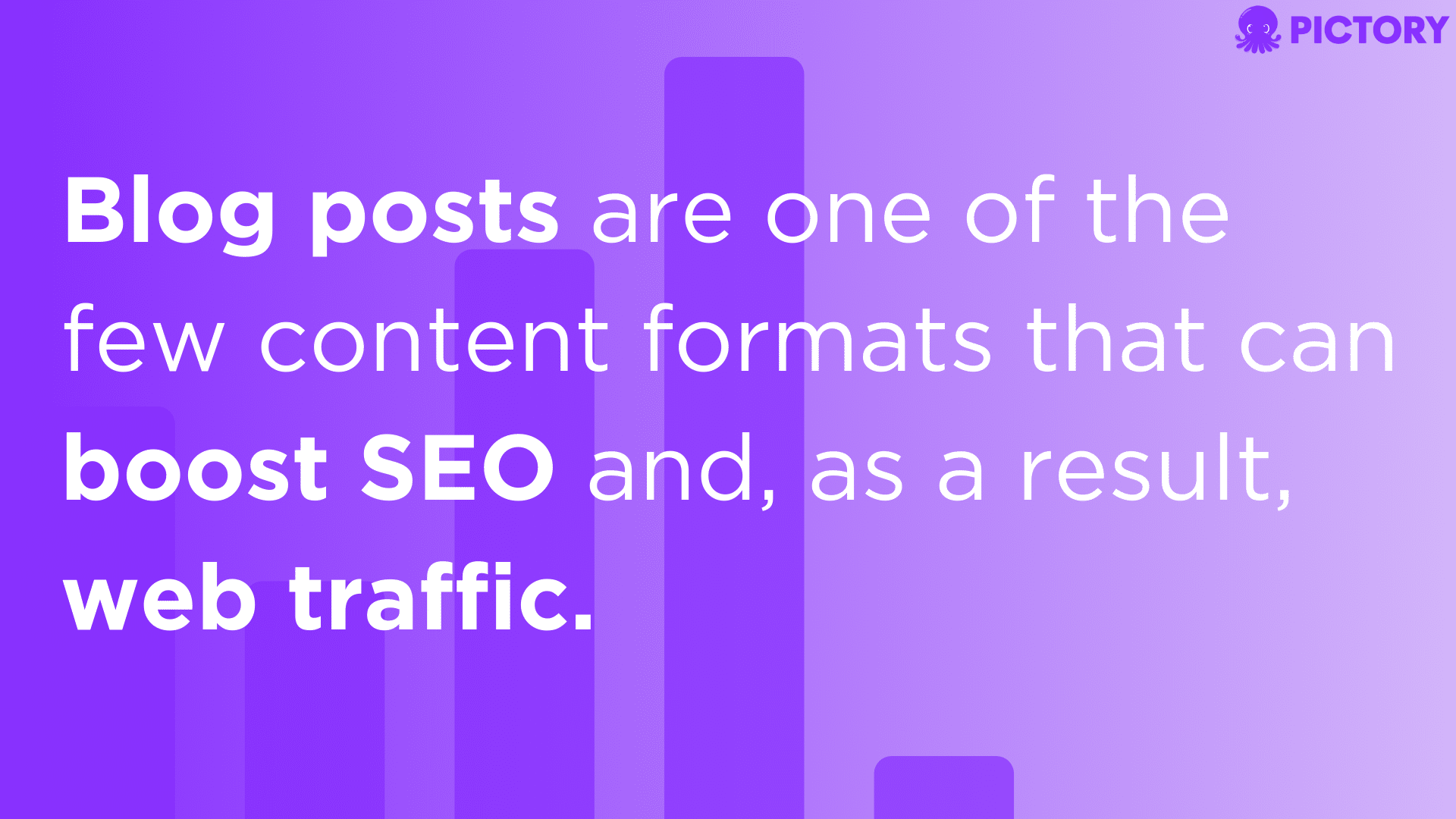
Creating blog posts almost seems retro these days in comparison to content like Instagram Reels, but it’s still one of the most important marketing tactics for any business.
Blog posts are one of the few content formats that can boost SEO and, as a result, web traffic.
They also provide an opportunity for brands to create more long-form content that goes deeper into topics than a Facebook post can, for example.
Podcasts
Audio content, be it through paid spots on third-party series or through a brand’s podcast, provides yet another useful avenue to reach different audiences.
Long-form content like podcasts allows a brand to highlight its area of expertise and also show why they are an authority in the industry.
And video podcasts have become increasingly popular, which creates twice the content to be built into a comprehensive strategy.
User-Generated Content
As the name suggests, user-generated content (UGC) refers to online materials created about a brand by the users, rather than the brand itself.
When loyal customers, for example, share posts on social media showing off a brand’s product, those posts count as UGC.
Online reviews and testimonials also fall into the same category and are instrumental in building brand trust.
And these are just an example.
There are some forms of content that are essential to a good marketing strategy.
Which ones you choose to utilize for your business depends on your brand vision and how they align with your business and content objectives.
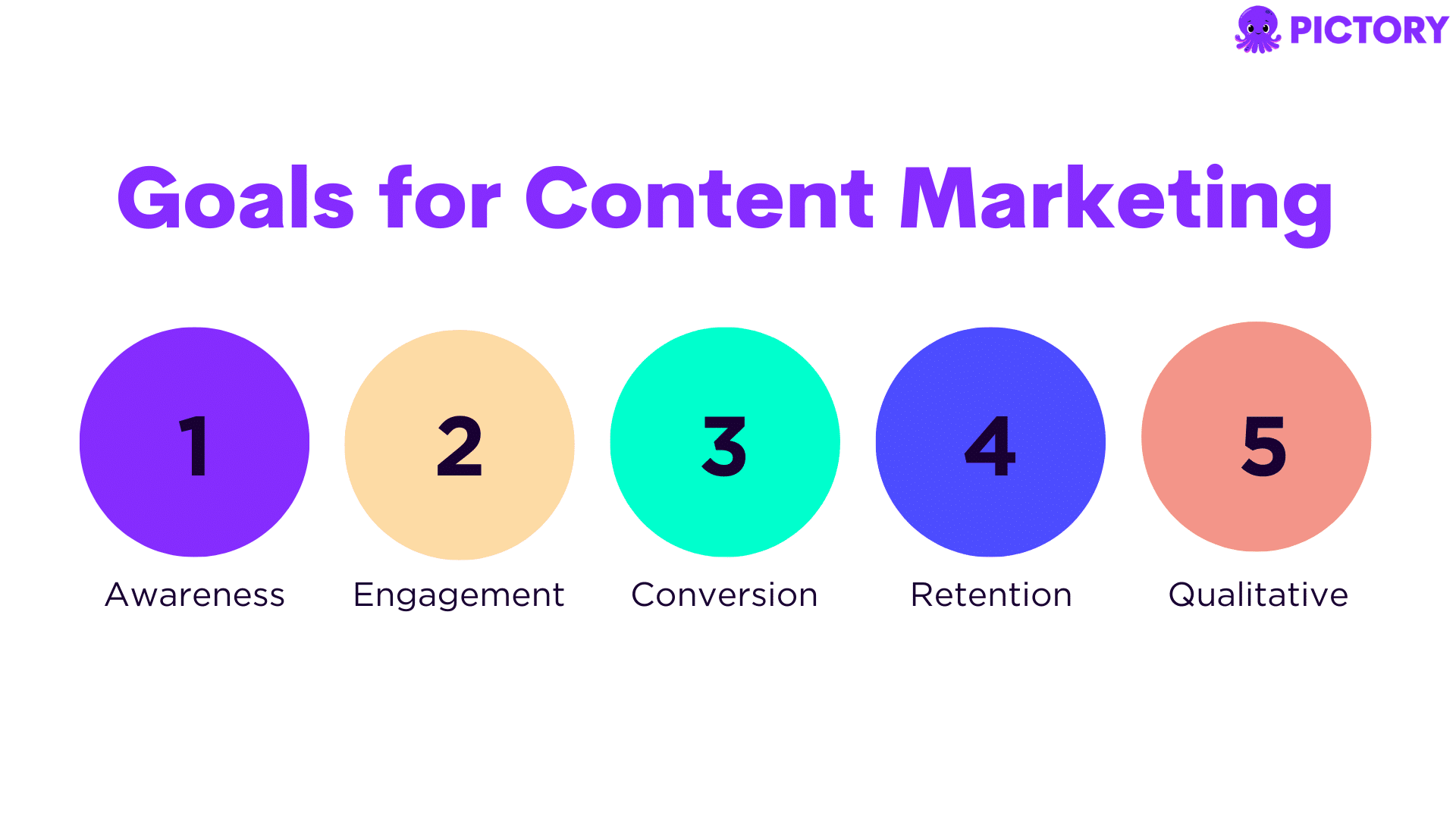
Objectives and Goals for Content Marketing
It’s not just formats that distinguish different types of content marketing, the different business and marketing goals that content can assist with are yet another area to be considered:
Awareness: In the traditional sales funnel, the awareness stage marks the start of the customer journey, when people are first introduced to a brand.
Awareness goals in content marketing are usually broken down into attracting more social media followers, boosting organic traffic, and getting content views from first-time visitors.
Engagement: Measured by looking at clicks, shares, likes, comments, and message responses, marketing goals that focus on engagement are primarily concerned with ensuring that content resonates with audiences.
Encouraging engagement also helps create a sense of community around a brand and can help with awareness as it draws added online attention.
Conversion: Conversion goals are usually the main priority of any sales team.
This side of content marketing is all about converting potential customers into active buyers.
Content with this kind of goal at the forefront usually focuses on influencing a profitable customer action.
For example, “click to purchase”.
Retention: Good content marketers know that targeting potential customers should only be one part of a marketing plan.
Existing customers also need attention.
Building a loyal customer following made up of people who continually return to your brand is one of the best ways to create a sustainable competitive advantage in an industry.
Qualitative: Some goals aren’t easily measurable but they’re still an important part of any content marketing strategy.
Examples of qualitative goals include establishing thought leadership, building customer relationships, and increasing the perceived value of a brand or its offerings.
Why Content is Crucial to any Successful Marketing Strategy
If your business wants an online presence, there is no escaping the need for high-quality, relevant content.
A marketing plan just isn’t complete without it.
It’s the main vehicle through which brands can communicate and connect with online audiences and used wisely, can make reaching marketing goals that much more possible.
Here are some of the key benefits that a successful content marketing strategy can offer businesses:
Establishing Brand Authority and Credibility
One of the big hurdles that every online brand faces is establishing a sense of authority and credibility.
Beyond internet scammers and fake news, spending money in general with a new brand always involves some risk.
When consumers are stuck in this phase of deciding if a product or service is worth buying, this is referred to as the “consideration stage”.
It’s a challenge that often arises in product marketing, especially with newer launches.
The newness of the product might attract attention but if there isn’t enough credibility established around it, consumers won’t trust it enough to buy it.
An effective content marketing strategy, however, can get businesses out of this rut.
Blog posts and video content can be used to show the product in action and get ahead of early hesitations potential customers may have.
This kind of content also operates as a way to establish your business as an industry expert.
Even just sharing content that shows a deep understanding of the issues a product solves, or the queries people might have implies a sense of authority that helps build brand trust.
Another way to use content marketing to garner customer trust is by prioritizing UGC – both the sharing of it and the promotion of content that incentivizes users to create it.
For example, many brands will automatically add users to a raffle to win prizes just for leaving a review.
GoPro and Canva regularly run competitions that reward users for sharing content made with their products.
Content marketing strategies like this not only show off products but the social proof that they work.
This, in turn, establishes credibility and boosts brand trust.
Increasing Brand Awareness with Content
A strong marketing strategy with content at the forefront can increase brand awareness through several avenues.
The most obvious is the reach and power of social media.
Facebook alone has about 2.9 billion active users each month.
This gives businesses a level of customer access that even the most widely distributed forms of traditional advertising and media could not compete with.
While paid ads on social media enhance the ability of content to reach people, a clever social media strategy can still largely rely on organic marketing.
Most social sites are free to use and, if leveraged properly, can create significant awareness while requiring comparatively little investment.
Instagram Reels has offered businesses huge value in terms of organic discoverability thanks to an algorithm primarily set up to show users content from accounts they don’t already follow.
That said, social media is by no means the only way that a content marketing strategy can increase brand awareness.
Blog posts have their own power.
Search engines rank sites based on the written content they contain.
This means that a well-written blog post can push up a website’s visibility in user’s search results, leading to greater brand awareness and organic traffic.
Content Marketing Enhances SEO
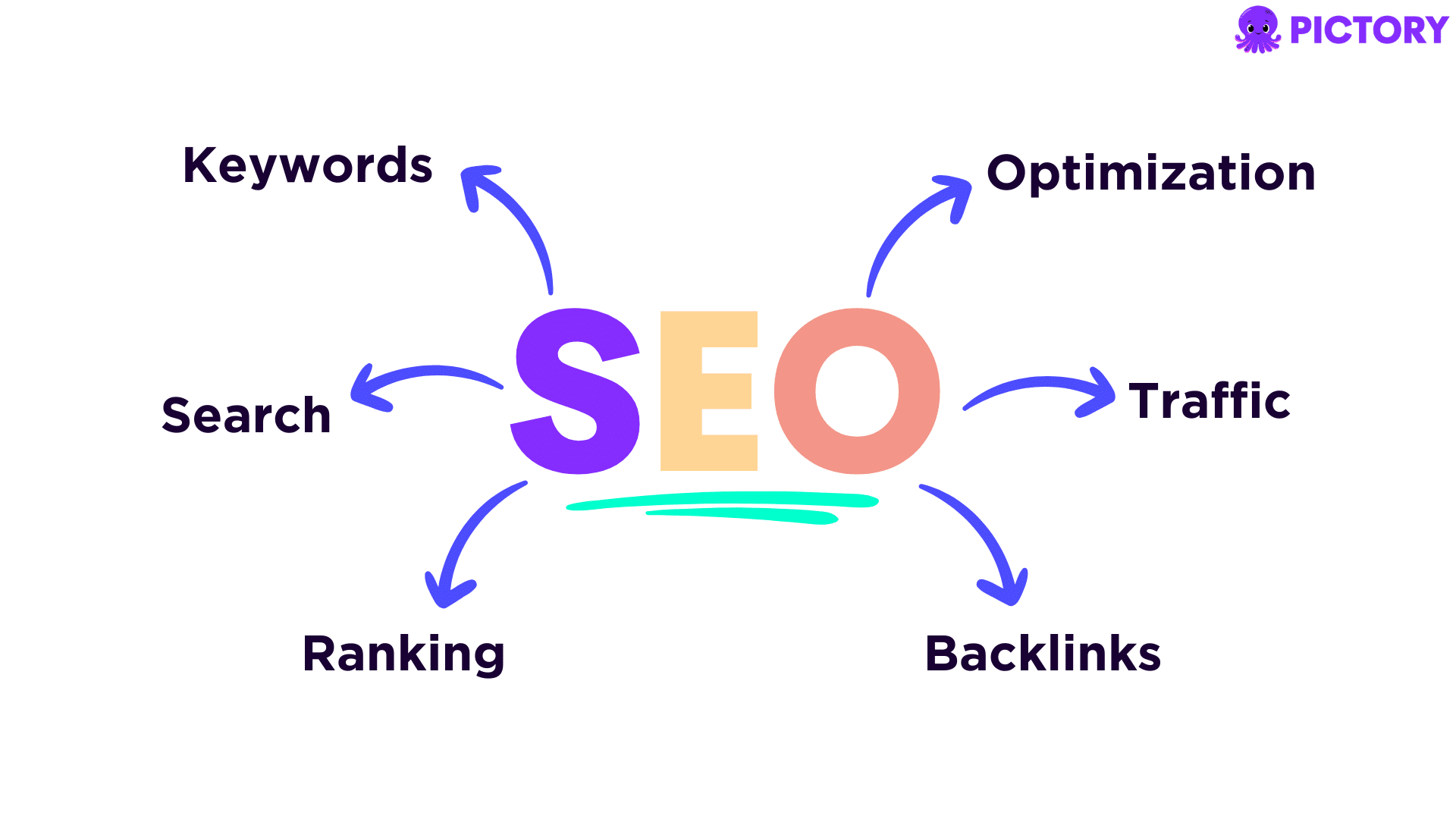
As we’ve just touched on, website content and how those sites are indexed and ranked on search engines are intrinsically linked.
Well-optimized blog post content can enhance the SEO of an entire website, but only with the right keywords.
That’s why keyword research is so crucial to any content marketing strategy.
Google Trends is a great place to start for keyword research but later in this article, we’ll also share some tools and platforms that can further assist with this side of a content marketing plan.
Driving Customer Engagement with Content
Creating content that resonates with your audience and builds customer engagement doesn’t just mean you get to show off how many likes a post has.
There are so many other ways that engagement in content marketing can help boost broader marketing efforts.
As a start, content that garners likes and comments develops a more interactive relationship between a brand and its target market than a magazine article can.
Small interactions can then quickly turn into a fully developed, active community of users who aren’t just absorbing key brand messaging but adding to it in their own ways.
Community building in general is one of those marketing objectives that keeps coming up.
For product marketing especially, the increased brand community is valued for the customer loyalty it encourages and the added excitement it can create around the product.
Content marketing is uniquely positioned to assist in this area.
With social media, blog posts, videos, and other formats, content gives customers a chance to see and speak with a brand.
That two-way dynamic of engagement isn’t just great for the engagement itself, but the ripple effect of community, loyalty, and interactivity that it brings too.
The beauty of content is that, unlike traditional product marketing, it isn’t a static thing.
It comes alive through customer reactions and shares.
Content Marketing helps Lead Generation and Conversion
We’ve mentioned the sales funnel at various points in this article but what about the content funnel?
For every stage of the sales funnel, there is a way for content marketing to address it.
Let’s break it down:
Awareness stage: Attraction content designed to draw new customers in and generate leads.
Consideration stage: Content designed to engage audiences, inform, establish credibility, and assuage any doubts about a brand’s performance or usability.
Conversion: Action content that prioritizes, for example, purchase clicks.
Retention: Content that supports existing customers such as newsletters that reel them back in, how-to pieces for anyone who already owns the products, and any updates on new launches.
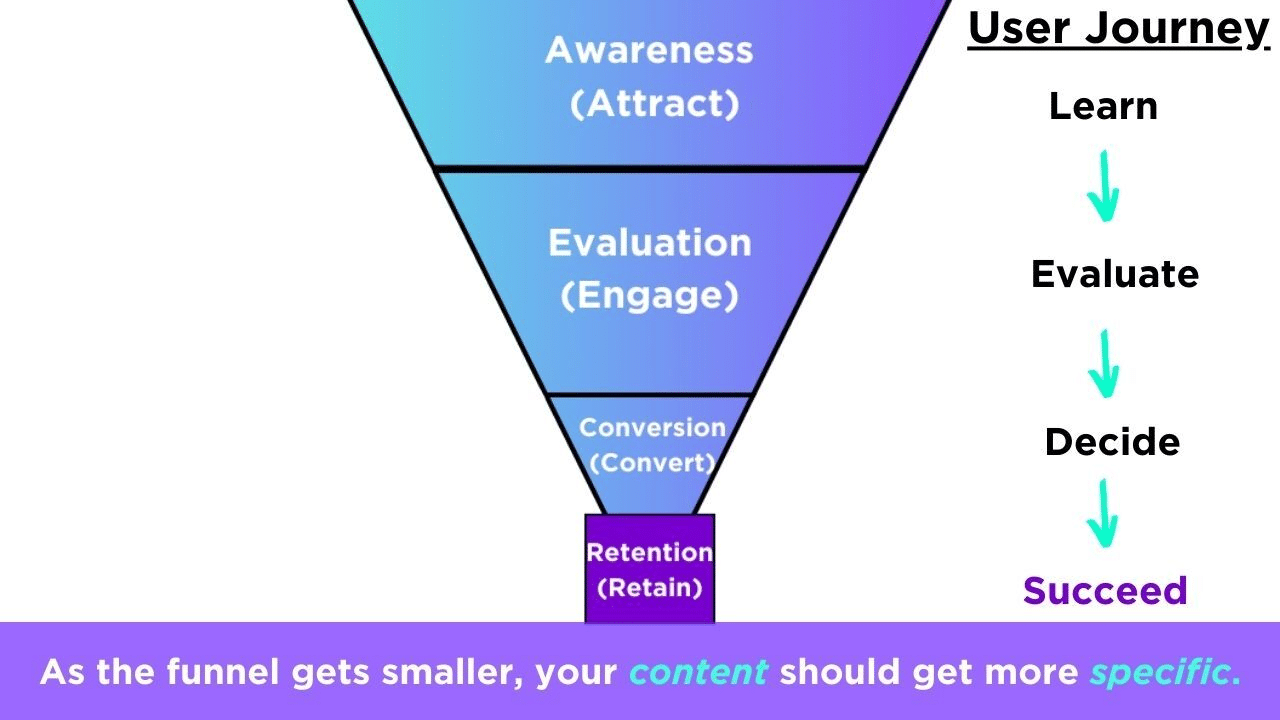
This hopefully shows that for sticky areas such as lead generation and conversion, content marketing provides businesses with a tool to nudge customers along the sales funnel.
Utilizing the content funnel correctly is a sure fire way to align your content and brand with user needs.
The interactive elements of social media also provide a great vehicle through which to research what might be holding casual browsers back from being buyers.
Comb through comments and messages and you may notice that pricing concerns are keeping people in the consideration stage.
At this point a blog post explaining your pricing better may help to assuage their doubt and convert them into customers.
Content Marketing Examples
One of the best examples we’ve seen in recent years of a big brand diverging from traditional product marketing mechanisms in favor of a content-led strategy is Dyson, the innovative home and haircare brand.
Launches like the Dyson Air Wrap not only came at an unusual premium for haircare but with a steep skills gap as well.
Part of the innovation of their tools is that they operate very differently from your average hair stylers.
Nonetheless, their products regularly sell out and have attracted a global customer base, with their content and social media strategy doing much of the work.
They’ve utilized influencer collaborations and live video tutorials in their marketing tactics to show customers how to use their products.
This makes their unusual tools seem more accessible while also emphasizing how unique they are – a marketing team’s dream combination.
A less pretty example of a content marketing strategy in action is Colgate’s resource pages.
They have hundreds of articles on their site to answer common queries about oral health.
This means that someone’s search query on gingivitis can quickly land them at Colgate’s door.
Colgate and Dyson’s content marketing strategies show how well content compliments product based marketing and what a vital role it plays in any larger marketing plan.
Creating a Content Marketing Strategy
With the value of a content marketing strategy well-established, the next question marketing teams and businesses always ask is how to create one.
Here’s a quick guide on how to create a marketing strategy that puts the very best parts of inbound marketing and content on show:
Setting Clear Goals and KPIs for Your Content
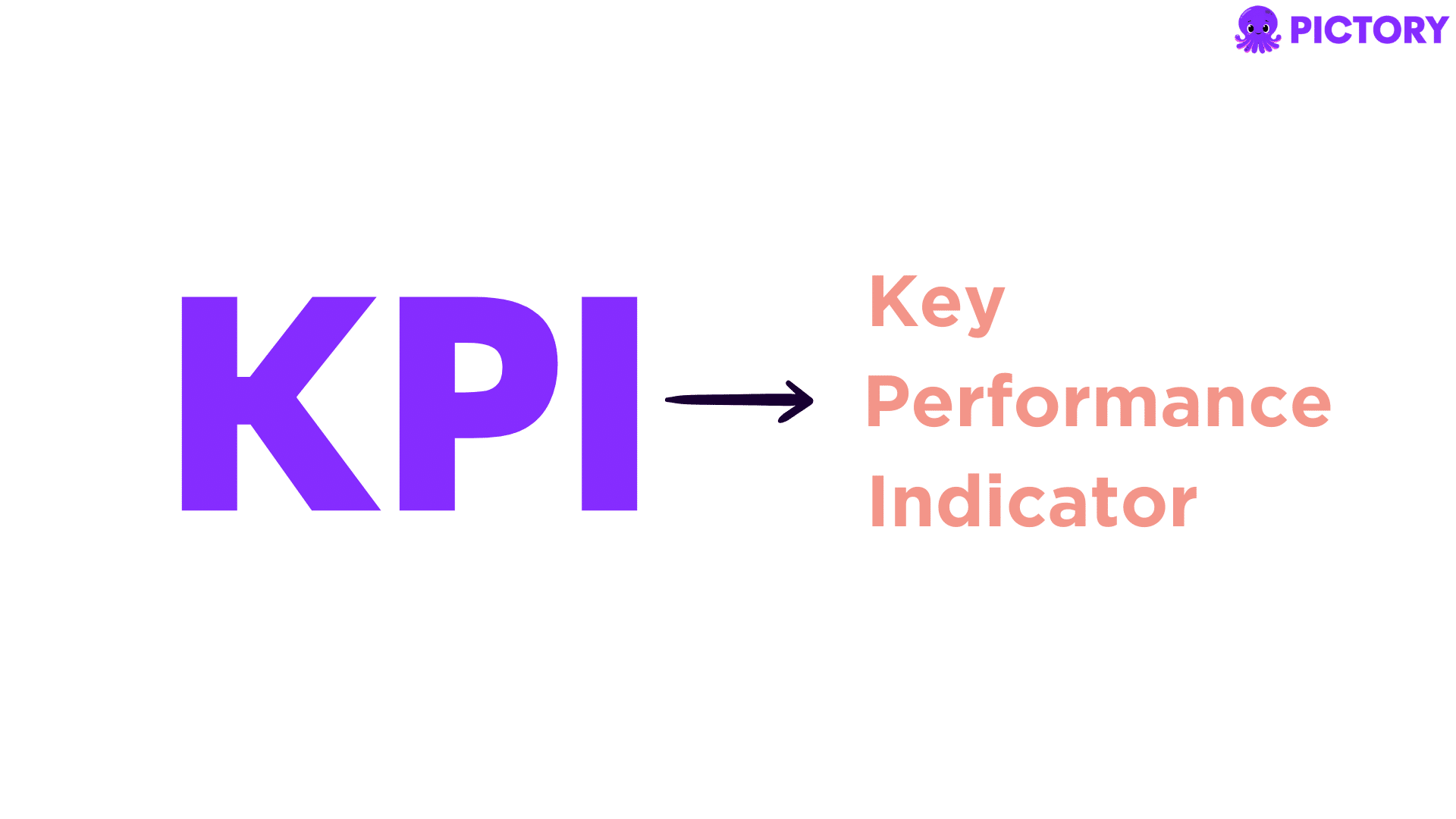
The first area to consider when you create a marketing strategy of any kind is what your overall business objectives are.
We’d recommend reviewing a business summary that shows a full picture of how operations are going and then developing goals that will make use of your strengths while fixing areas that need improvements.
For every goal, however, there needs to be a KPI by which to measure its impact.
As an example, aiming for more leads can be measured through the number of first-time customers a site gets in a month or site click increases.
If you’d like a more in-depth look at the issue and to see an expanded list of KPI examples to use, check out this article on setting the right content marketing goals.
Identifying your Target Audience
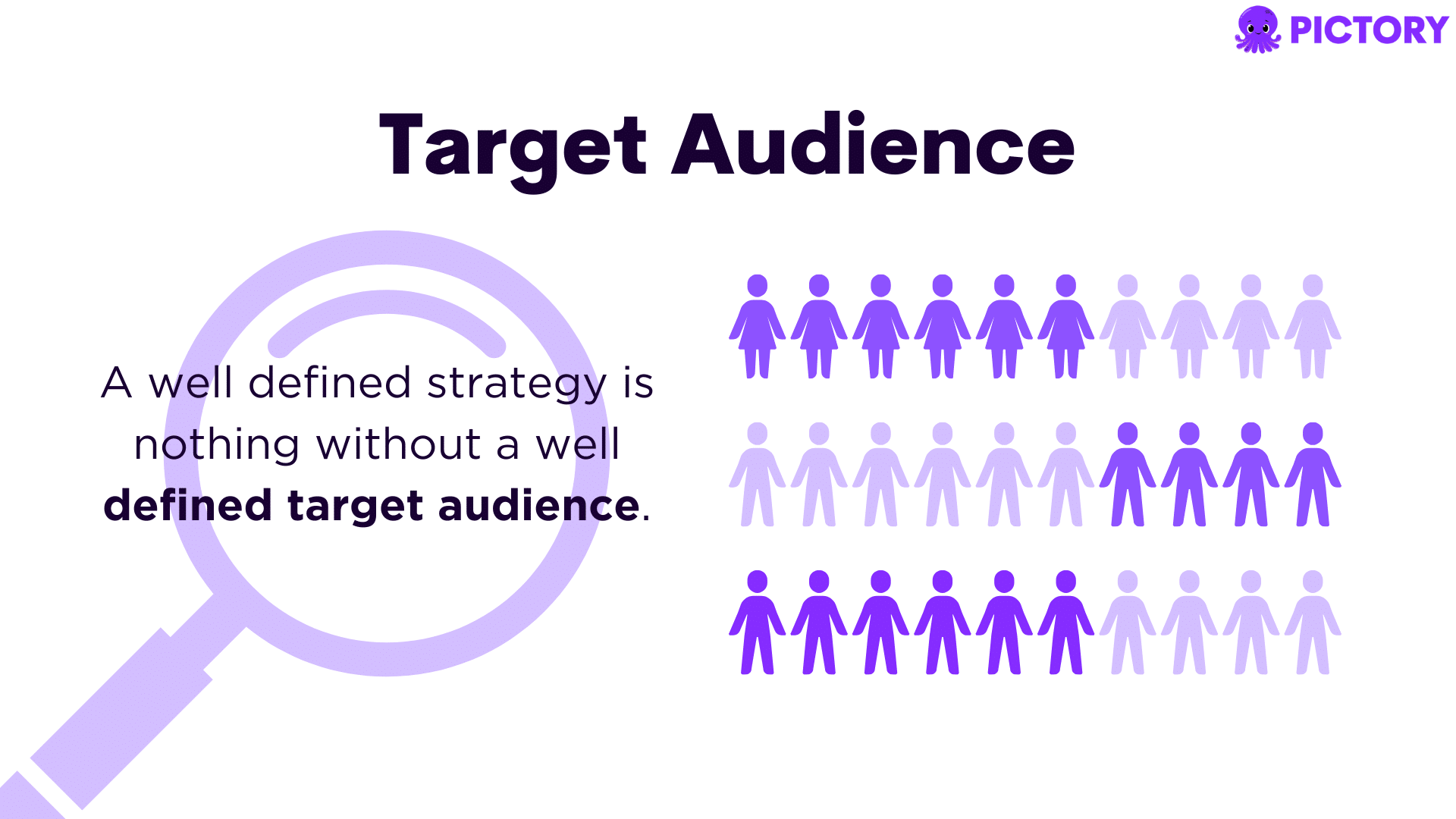
Content marketing success is predicated on good communication.
One of the best ways to improve communication and product targeting is by building a clear idea of who it is you’re talking to.
A well-defined strategy is nothing without a well-defined target audience.
To get a clearer idea of the target market you’re trying to create content for, consider using buyer personas.
These individual examples of your target customers can provide huge clarity on the tone, style, formatting, and even platform that your content should prioritize.
Content Ideation and Planning
Investigating and defining your target audience, from basic demographics to common pain points they may have, should reveal multiple points of entry for content.
Try to map out content that is relevant to your target audience and will provide support throughout the sales journey.
Something that assists hugely with content ideation is doing a bit of market research.
Look at what competitors are doing, especially ones with the same target audience.
You may very well identify gaps that can be leveraged for your content.
Make sure your marketing strategy also outlines clear deadlines on new product launches etc. as content needs to be developed around this.
Information like this, as well as relevant holidays and posting deadlines, should all be included in an editorial calendar.
Content Creation and Distribution
Alongside target audience development and content ideation, every good marketing campaign requires a clear plan on how that content will be made and distributed.
We’d always recommend using at least three different types of content formats in your marketing strategy and making sure to do proper market research to see how your content can stand out in the crowd.
Something to consider with content creation and distribution is scheduling cross-promotional content into your editorial calendar.
For example, if your business just released a new piece of podcast content turn the video into a short highlight reel for your socials.
Got a new long-form YouTube series?
Chat about it on your blog.
There are so many ways to double up on content if you get smart about your distribution strategy.
Measuring and Analyzing Content Marketing Results
There is no way to judge if you have a truly effective marketing strategy in place unless you’re looking at marketing analytics regularly.
Many make the mistake of leaving analytics as an afterthought, whereas it should be an ongoing, intrinsic part of a content marketing strategy.
Clicks, engagement, and other KPIs will highlight content worth replicating as well as areas that perhaps need more attention.
Make sure not to take numbers simply at face value though.
Teams will often report success in their marketing strategy simply because it led to follower count increases, but if most of those followers don’t even fit the target market, it may be time to re-visit buyer personas.
The online and social media landscape is ever-changing and as much as we try to exert control with careful content and strategies, flexibility is key to survival.
Keeping an eye on analytics helps businesses see the changes and problems before they’re hurt by them.
Adapting and Optimizing the Content Strategy
We’ve slightly stolen from this point already but adapting and optimizing your strategy is a must.
Content isn’t static, and neither is a marketing strategy.
New trends, insights, and app updates are constantly popping up and the more ready you are to evolve your content with it, the more likely you’ll find those changes can lift your business rather than drown it.
Common Content Challenges and How to Overcome Them
The boost that a content marketing strategy can provide can also be frustratingly easy to stall.
Here are some of the common challenges we’ve seen trip businesses up on their content journey:
Generating Consistent Content Ideas
When this problem arises, go back to your audience and business goals.
Consider which objectives still need reaching and the areas your audience still needs clarity on.
Comment sections are a great place for inspiration, as is your existing content.
If you notice that a certain format or style keeps doing well, try to give it a fresh take.
Another tool for generating consistent ideas is doing regular market and trend research.
This includes everything from keyword research to paying attention to the voices and brands in your industry that seem to be garnering attention.
Allocating Resources and Budget for Content Marketing
Two things make resource and budget management easier as you create content: an editorial calendar to keep you on track, and analytics to back up your decisions.
Check the ROI on previous content shared to ensure that you’re getting enough of a return on your content investment to make the spend worthwhile.
It’s worth remembering that whilst organic content marketing might not look like it’s generating as much revenue as paid ads or your sales team, it is invaluable.
The brand authority and community help to generate content that ends with content marketing as a very cost effective form of marketing.
And it’s even easier to scale your content marketing efforts on a budget with the inclusion of AI tools such as online video generators and AI writers.
Balancing Quality and Quantity
This is tough for every business.
Brands want to put out lots of content to stay visible but if the quality drops, they risk losing their audience and undermining the entire endeavor.
Go for consistency rather than just quantity.
Build a calendar that includes regular uploads in multiple formats and platforms and try simply sticking to that rather than frantically making content for the sake of it.
Planning like this also makes it far easier to maintain quality as teams are less rushed.
As you’ll see, there are also plenty of online tools that can be used to ease the burden of making content.
Staying Up to Date with Industry Trends
The internet moves quickly.
The trending influencer or video format this week is likely to be very different from what goes viral in a month.
Chasing trends is great for getting clicks but to manage this pressure better, we’d advise that brands try not to hop onto every trend.
That’s where things can get exhausting.
Instead, balance general trend research with things that are specifically relevant to your industry or affecting your audience.
This ensures that you stay on the beat of things, without getting completely overwhelmed.
Tools and Resources for Content Marketing Efforts
With all of the above challenges in mind, there are plenty of tools and resources to help businesses create content in a way that is more effective and efficient.
Let’s take a look:
Content Management Systems (CMS)
This kind of software helps businesses build and manage websites without any coding knowledge required.
Some examples include:
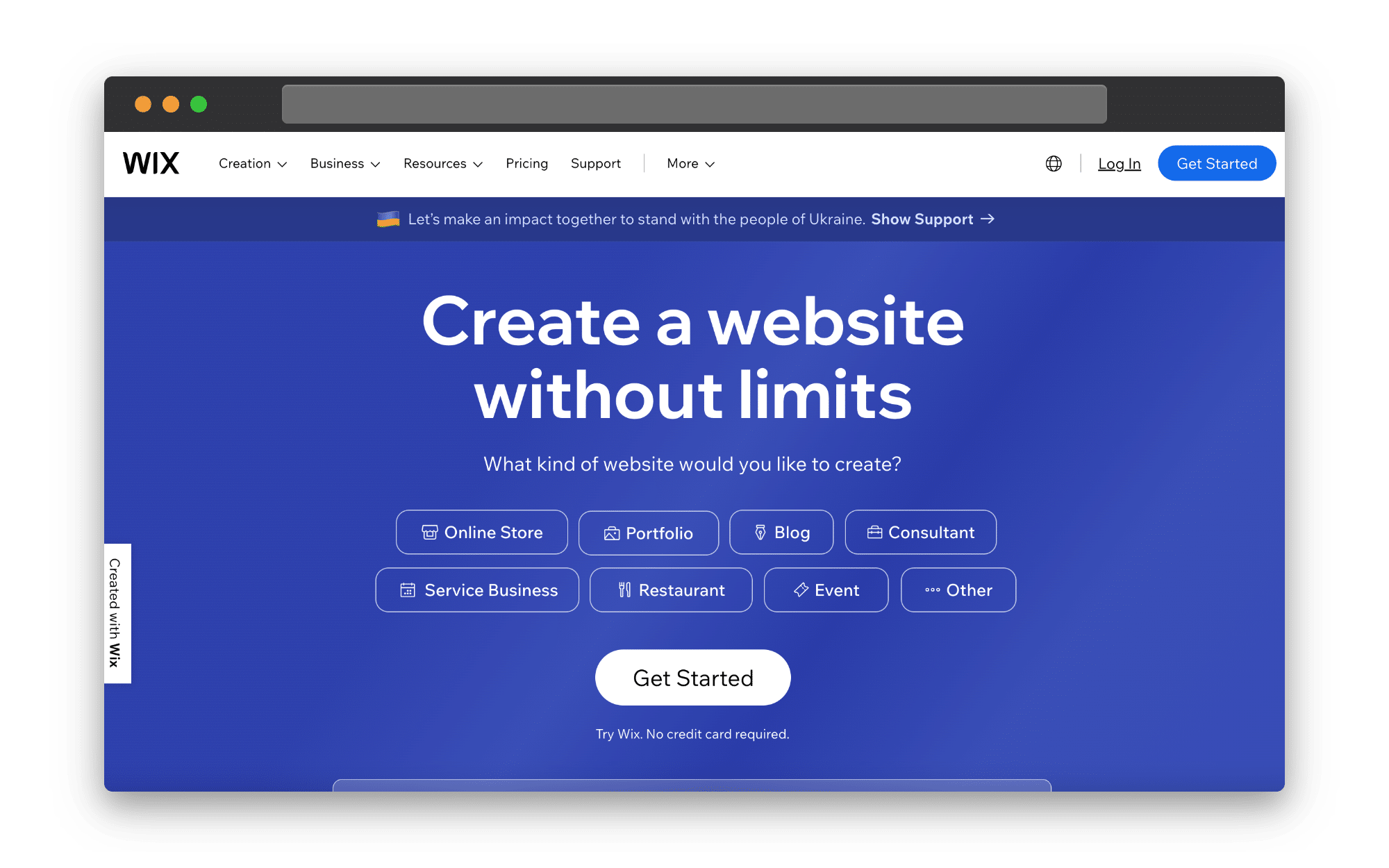
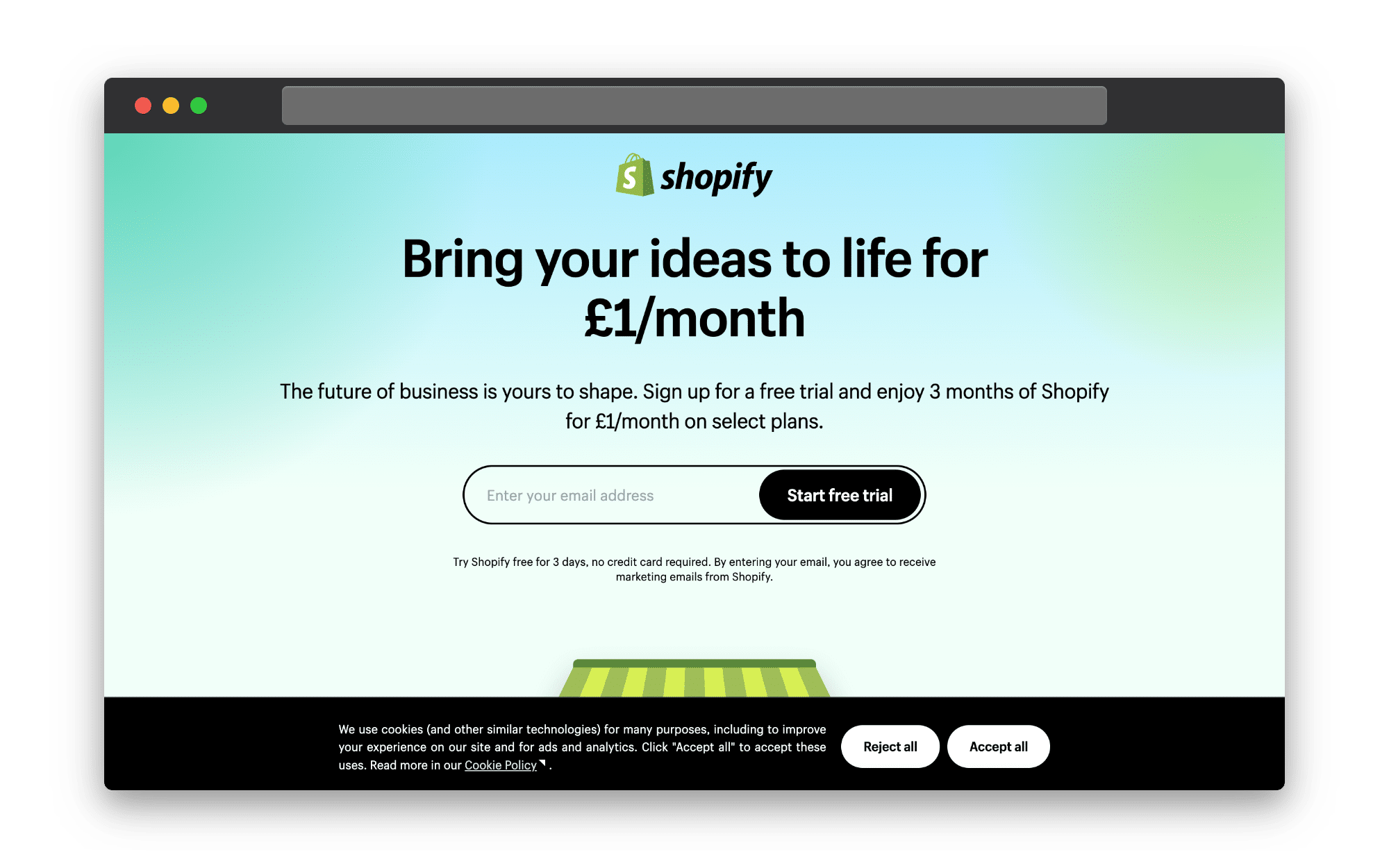

SEO and Analytics Tools
We’ve mentioned a few times in this article how important SEO is when it comes to content development and a marketing strategy.
Here are some SEO and analytics tools that can help:
Many of the CMS options we listed, such as Shopify and Wix, also provide in-house analytics.
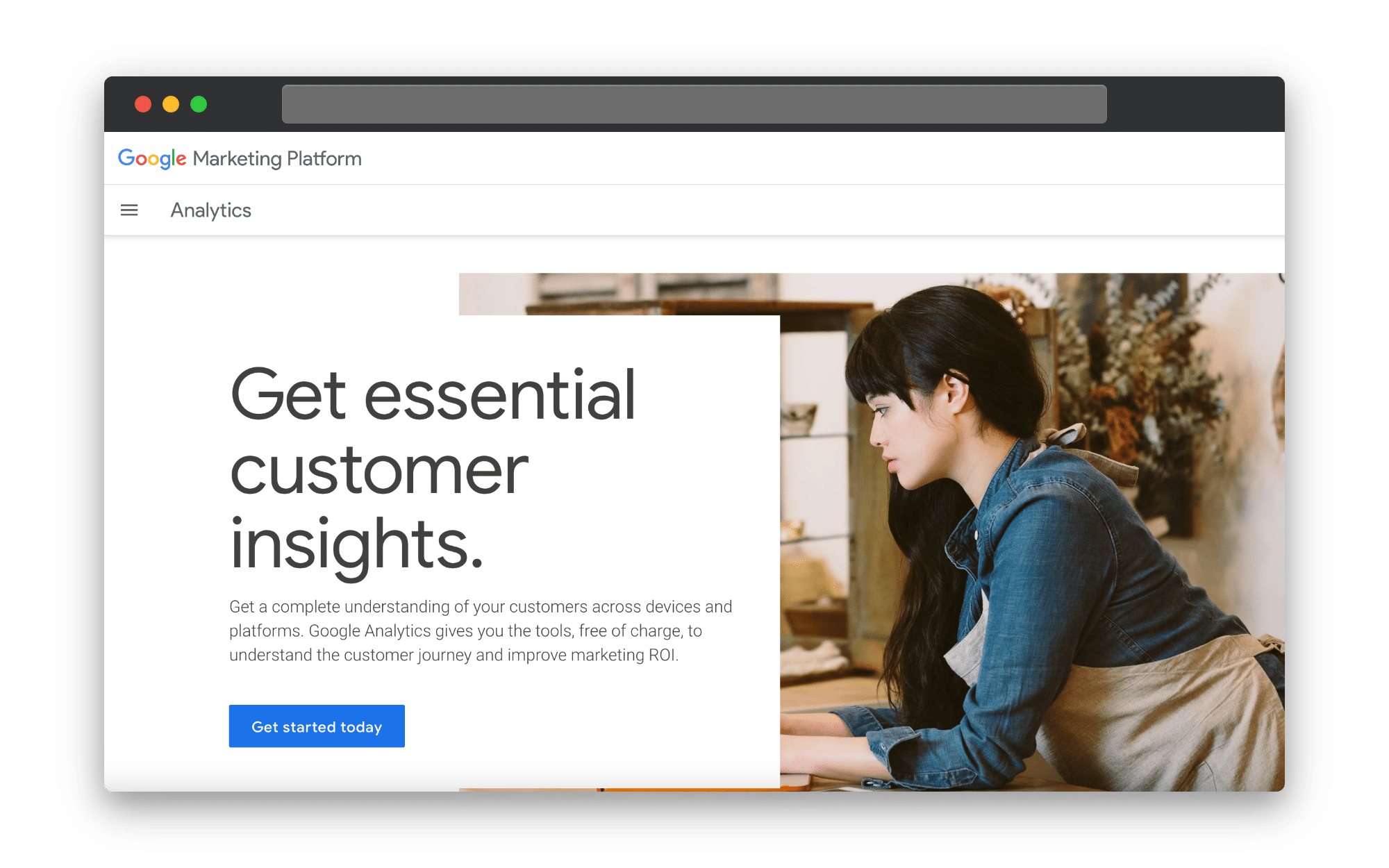
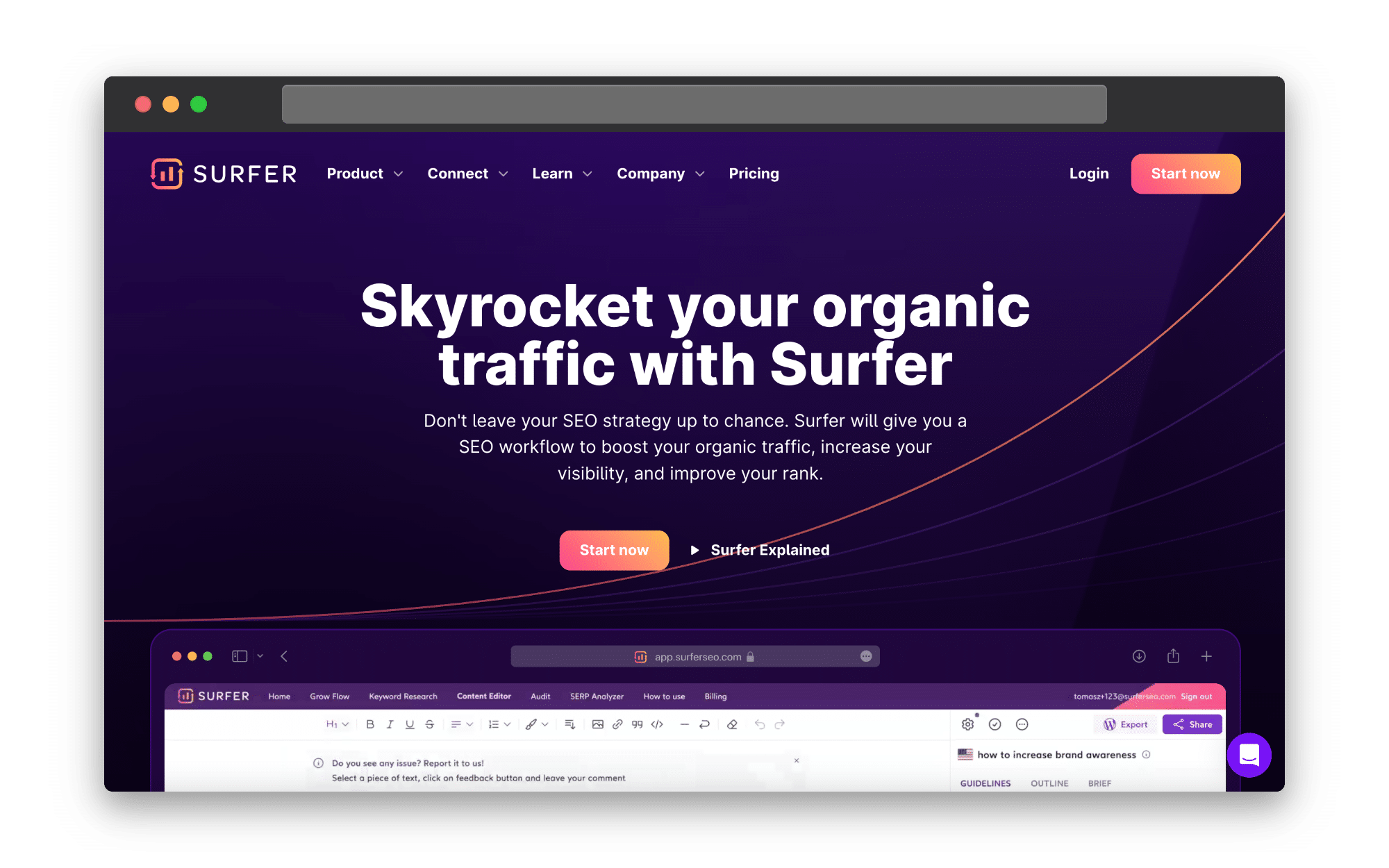
The same is true of most social media apps as well.
Content Creation Tools
AI is your best friend when it comes to making content.
For video content, we of course would suggest looking at our AI-powered software.
We can help you edit and create videos in just minutes, no matter your skill level.
For written content, AI tools can again be incredibly useful.
AI writers such as ChatGPT can be a great asset for social media posts and other written content.
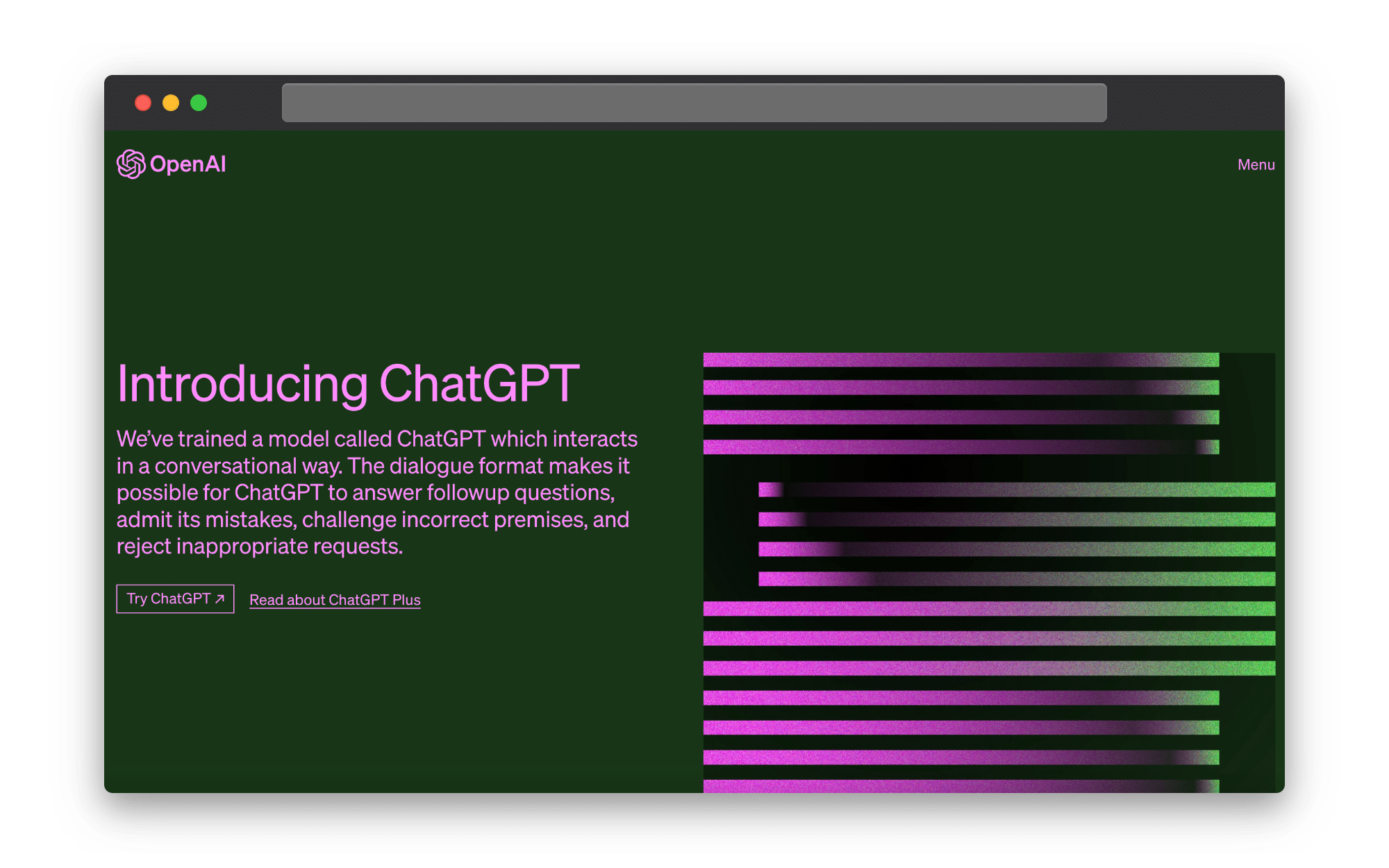
And any text you create using any AI writer or your own know-how, can be turned into an engaging video in minutes with Pictory.
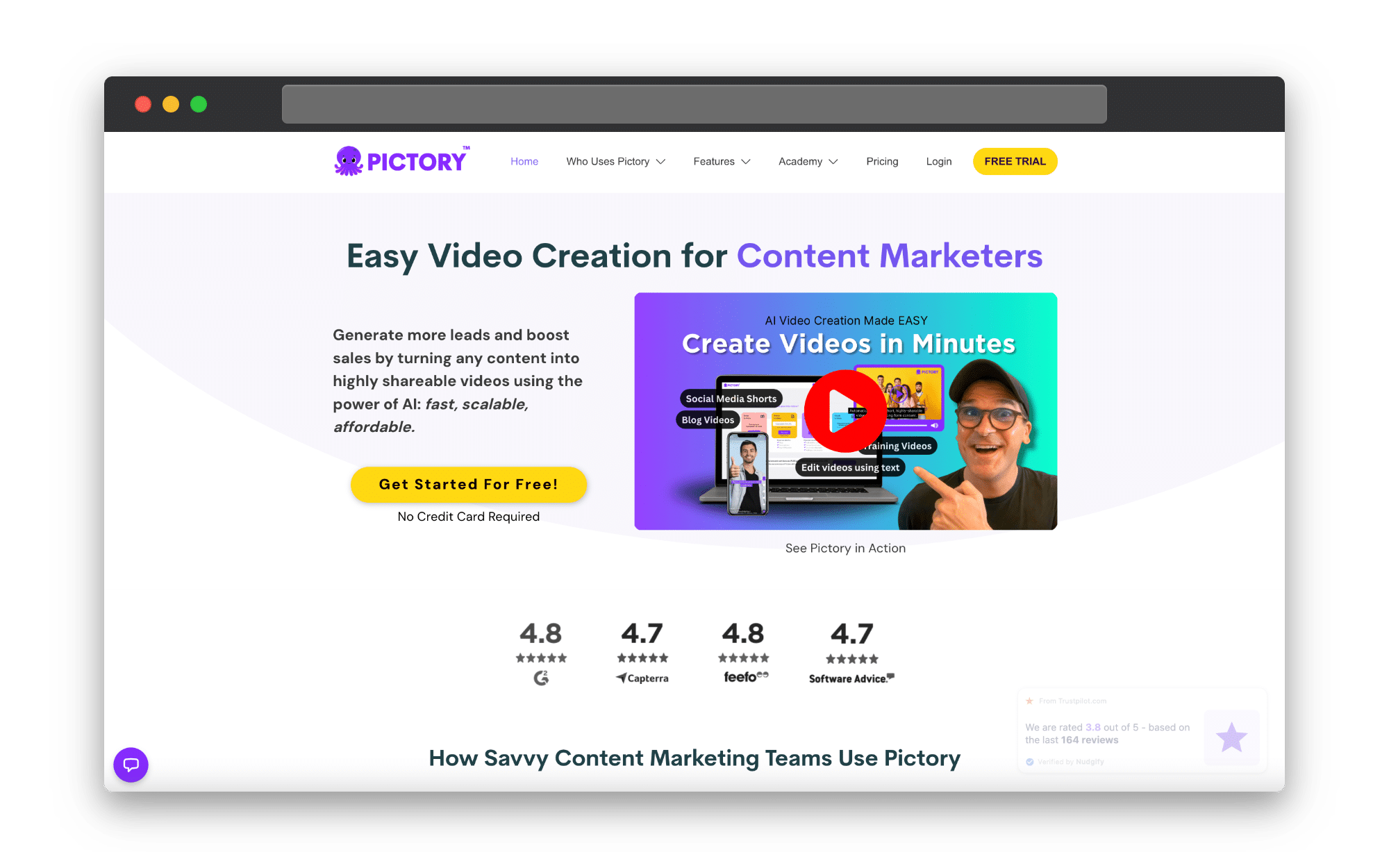
Give Your Marketing Approach a Boost
Whether it’s brand trust, industry authority, or conversions that you’re after – content is the key to giving any marketing strategy a boost.
Just make sure that as you develop that content, it’s led by clear objectives, a strong sense of your target buyers, and tracked with great analytics.
Content alone isn’t anything special, but when it’s shaped by a strong strategy, there’s no cap on how far it can take a business.
When it’s time to build your video content marketing strategy, Pictory is the online video editor you need in your arsenal.
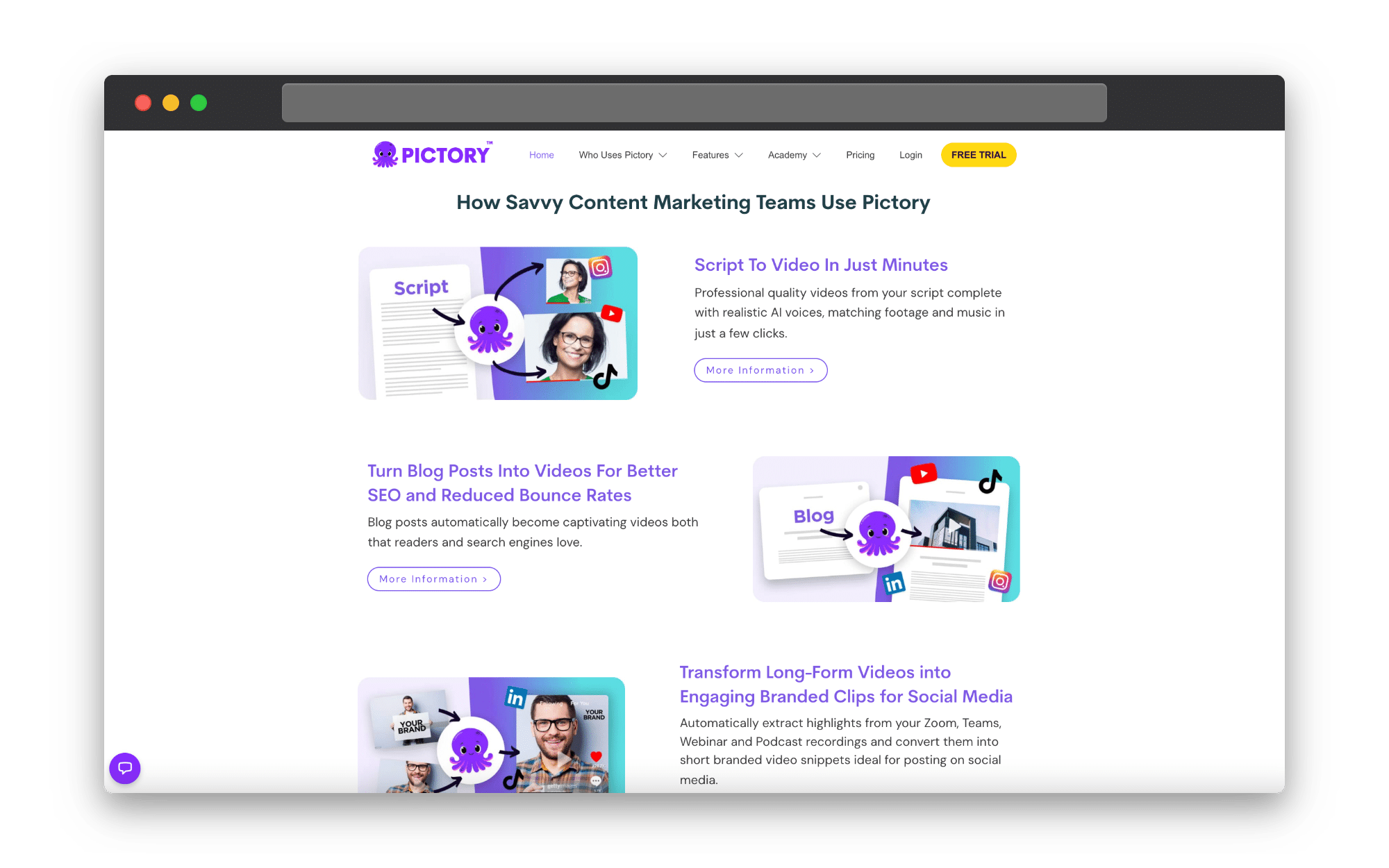
No bulky software download. No expensive freelancers. video editing experience needed.
Just quality video content that will convert users fast.
Sign up for a free Pictory account today and see what our AI-powered content can do for your marketing strategy.

